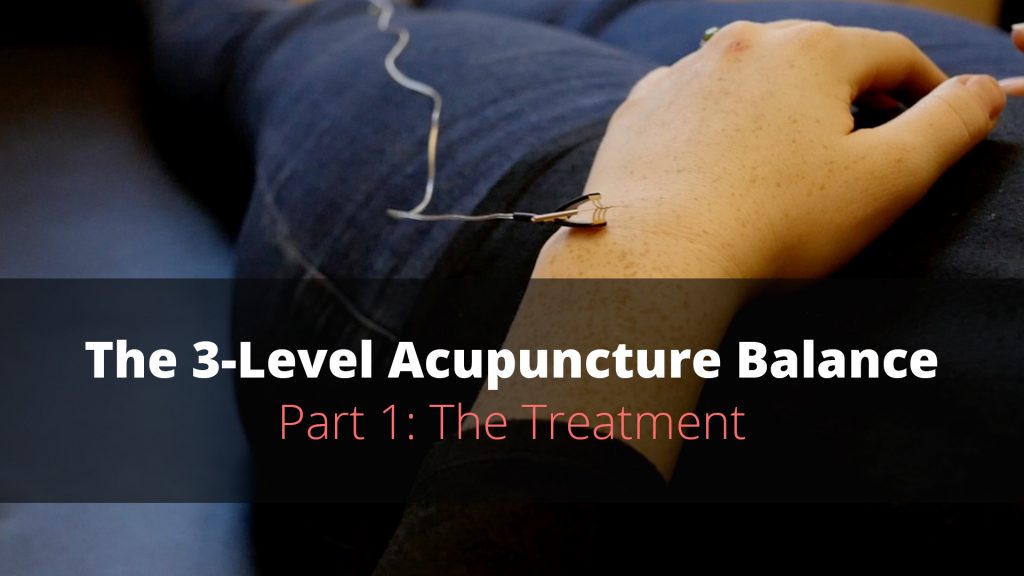
Over the last number of years, I have been using AcuGraph to guide me in a protocol I have come to call the 3-Level Acupuncture Balance. Over the next couple months, I will present a series of posts describing what this balance is, why I think it offers a deep and profound treatment, and the history of its development.
In this first post, I will jump right to the mechanics of how to perform the treatment so you can put it into practice right away.
The 3-Level Balance
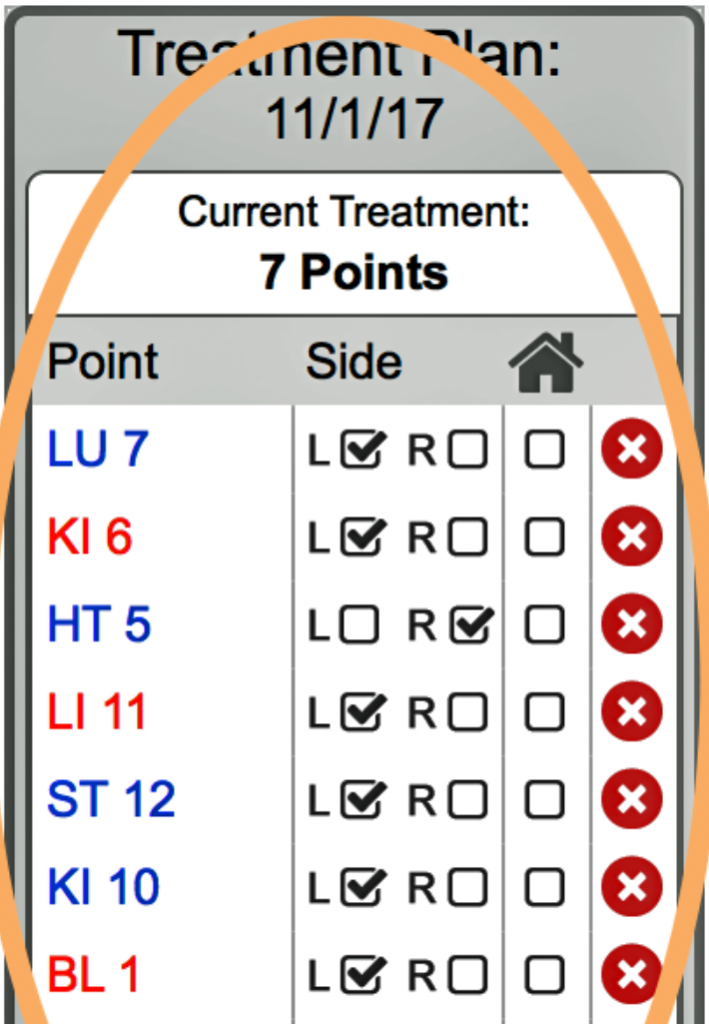 The 3-Level Balance is the culmination of work started in the 1970s with Yoshio Manaka, developed through his followers at the Topological Society in Japan, and brought to fruition through Miki Shima’s Somatic-Auricular Therapy (SAT) in the 1990s. Thanks to Adrian Larsen, the diagnostic aspect is now incorporated in the AcuGraph menus, making this very interesting acupuncture approach available to ALL of the users of the AcuGraph.
The 3-Level Balance is the culmination of work started in the 1970s with Yoshio Manaka, developed through his followers at the Topological Society in Japan, and brought to fruition through Miki Shima’s Somatic-Auricular Therapy (SAT) in the 1990s. Thanks to Adrian Larsen, the diagnostic aspect is now incorporated in the AcuGraph menus, making this very interesting acupuncture approach available to ALL of the users of the AcuGraph.
The 3-Levels are the primary channels, the 8 extraordinary channels, and the divergent channels. The primary channels are responsible for moving and regulating qi and blood. The 8 extraordinary channels are responsible for balancing and treating the musculoskeletal body, and the divergent channels balance and regulate the internal zang-fu organs.
The basic treatment for these three systems requires only 8 needles, providing a very efficient, yet deep approach for promoting self-healing, boosting vitality and enhancing immune response. This basic treatment serves as a foundation root treatment that can then be followed with branch treatments using ear, TCM, Tung/Tan symmetry balance, etc.
The Treatment
There are many subtleties to performing the treatment, which I hope to cover in future posts. But today I will show you how to diagnose and give the basic treatment. This basic treatment regulates the eight extraordinary channels and the divergent channels, which in turn will take care of most primary channel imbalances. Honest! In a future post, I will teach you how to enhance and balance the primary channels as part of the overall 3-Level Treatment.
The treatment involves Japanese needling: thin needles with relatively superficial insertion. It also involves ion-pumping cords (IPC), which move electrons in one direction, only. Ion pumping cords are used to move excess energy of one channel to a channel with deficient energy. Ion pumping cords (IPC) were developed by Yoshio Manaka, and are a very efficient way to balance meridians.
More about ion pumping cords here >>
Step 1: Graph
Start the treatment by taking the basic reading with the AcuGraph, using the yuan-source point diagnosis. It is important that the readings are done carefully and accurately. It is somewhat of an art to get accurate readings, but can easily be learned by any AcuGraph user.
For myself, I expect the right and left readings for each meridian to be within 12 points of each other. If not, I will re-measure both points again. Often, careful attention to point location and pressure will bring the two readings closer together.
About 20% of the time the points won’t fall within the range, but by re-measuing, you can be sure the reading isn’t off because of user error.
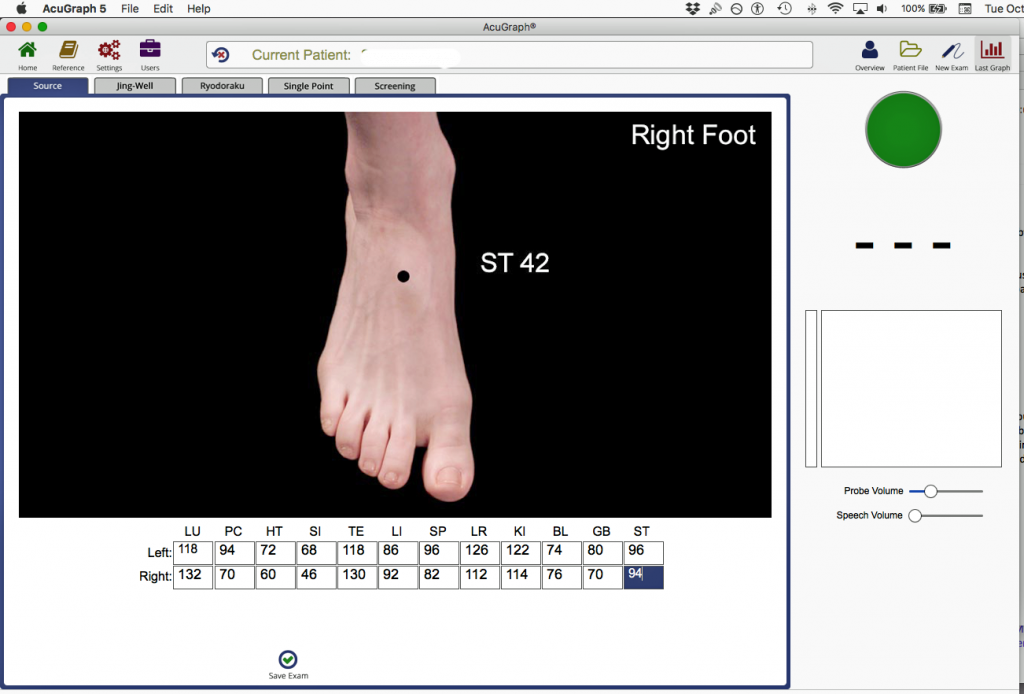
Once the reading is complete, the basic bar graph will show for the patient. In the lower left side of the menu are “treatments”, which display 6 different icons (see picture below). The top three show red-blue bar drawings, while the bottom three show, in order, an ear, a body with spine, and finally two arrows diverging from a single bar.
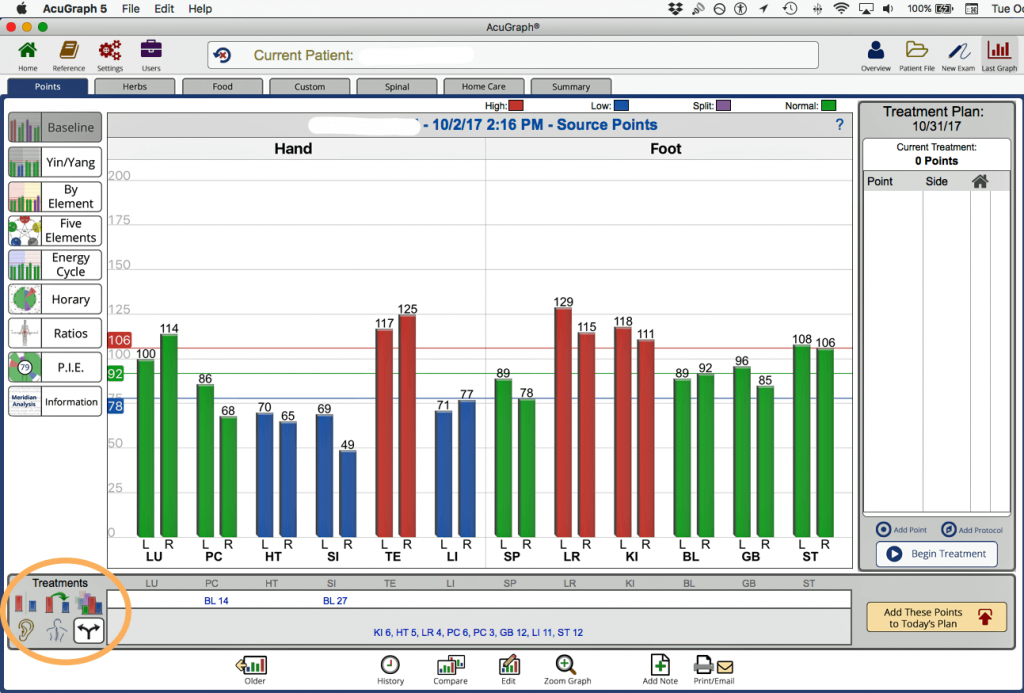
Step 2: The Divergent Treatment Points
The last icon on the far right, the split arrow, is the Divergent treatment icon. When you press this icon, the points for the treatment show on the bottom center of the graph. Next, go to the bottom right side of the menu, and press “Add These Points to Today’s Plan”. The points will appear in the “Treatment Plan” box, on the right side of the AcuGraph window (see picture below).
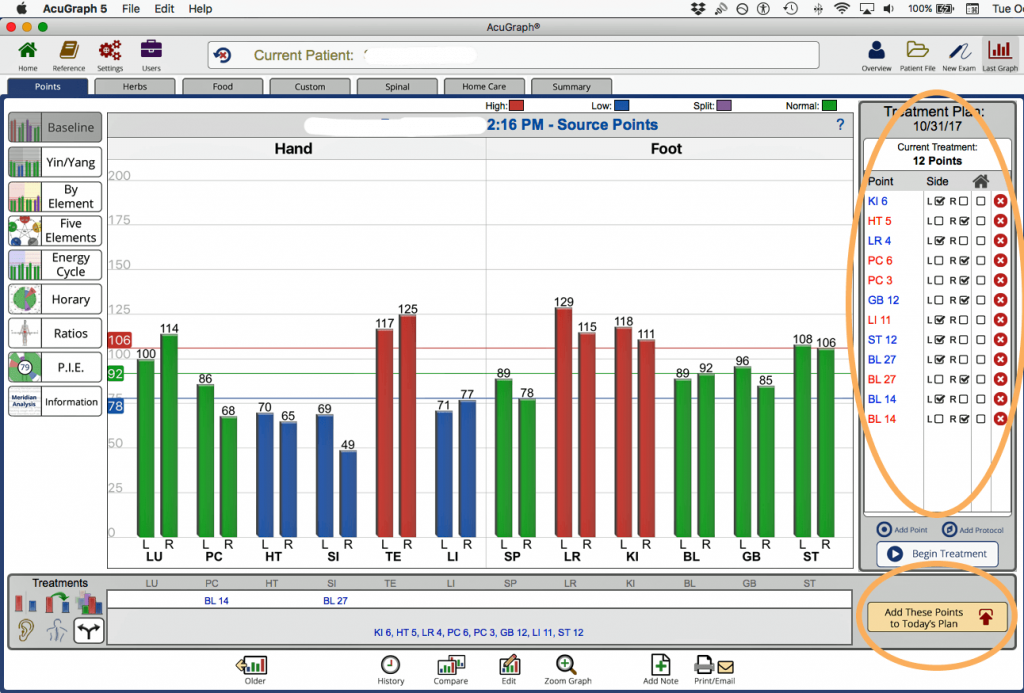
For clarity, I chose to X-out and remove the last (bottom) 4 points. These are Bladder-shu points that I don’t use in the basic protocol. (We will talk about them in a future post.)
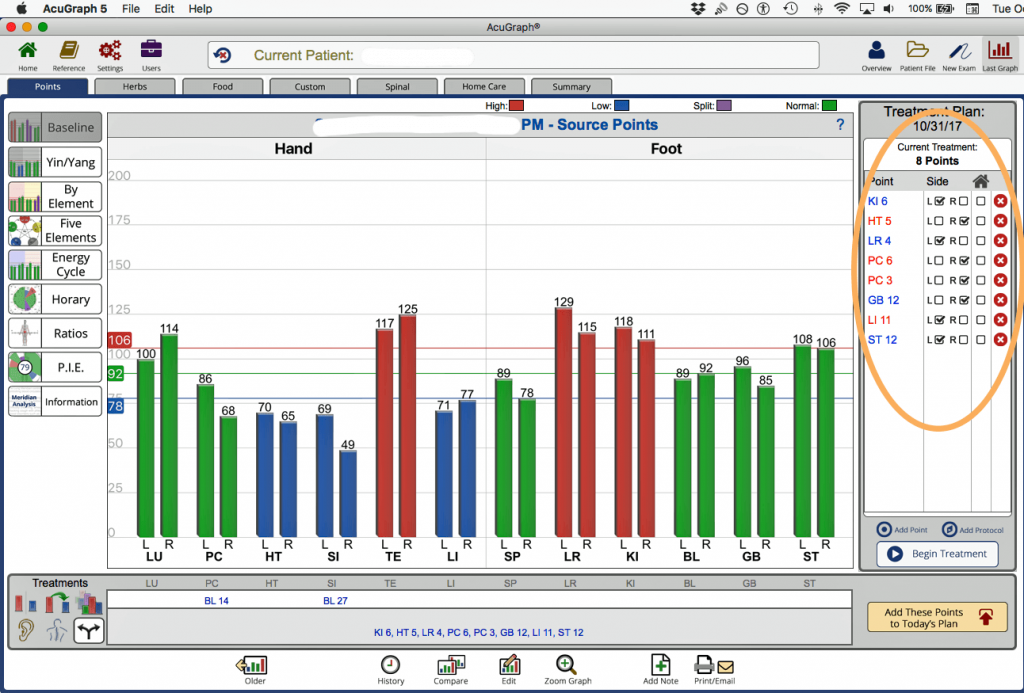
Now that the Bladder-shu points are removed from the Treatment Plan, we have two groups of points, the upper half and the bottom half.
Let’s talk about the upper half first. By upper half, this is typically the upper 4 points listed, but occasionally it is only the upper 3 points. These are the points that will balance the Eight Extraordinary Channels. The points are listed as either blue or red, and only one side is checked (see picture above). The points are in order: the first two points are one pair, the second two points (typically) are the second pair. For the 8 Extra treatment, paired points can be unilateral, or cross lateral, so pay attention to which side will be treated.
For the Divergent treatment, the bottom group of 4 points, the pairs are always unilateral, that is, paired for the same side. Sometimes both pairs are on the same side, sometimes one pair is on one side and the other pair is on the other side.
What is A Divergent Treatment?
What is a Divergent treatment? Before the Japanese developed a Divergent channel protocol in the 1970s, the channels were discussed in theoretical terms only, going back to Chinese classical texts. But the basics were understood.
Divergent channels dive at the he-sea points and go through the organs, surfacing again on head or neck points. Each yin and yang pair of a specific element/phase, such as LU-LI, SP-ST, etc. has their divergent channel meet and help each other. The channels were seen as an internal way to regulate the zang-fu organs, and more importantly, to protect the organs from exogenous pathogenic factors. More on this in a future post!
Going back to our listing of 7 or 8 points in our “Treatment Plan” window, how do we know if we are using 4 or 3 points for the 8 Extra treatment? The bottom group of points, used for the Divergent Channel balance, always contains 4 points, so count UP. The total (once you removed the very bottom Bladder-shu points) will be either 8 or 7 points. If there are 7 altogether, the top group, for the 8 Extra, will default to 3 points only. In those cases, the two pairs share one common point, that is, a point is used twice, for two different pairs. Confused? I hope not!
So to review:
- Take the reading at the yuan-source points
- Choose the Divergent icon (bottom left) and add to Treatment plan (bottom right)
- Remove the bottom 4 bladder-shu points

Step 3: Create a Chart
I like to graph out a chart so I know exactly how I will be placing my needles and cords, with the 8 extra points listed above and the Divergent points listed below. I put this with my needle tray in order to guide my treatment.
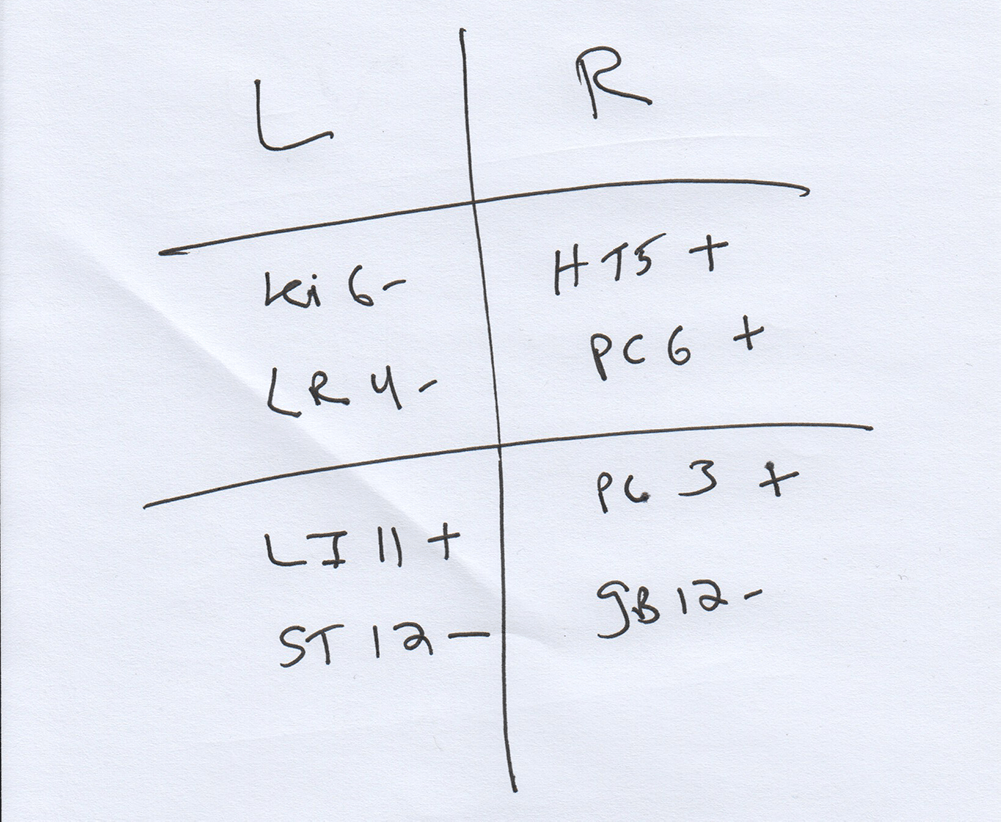
Step 4: Extraordinary Treatment
insert the needles
Now I am ready to treat. Have the patient lay face up on a table. I usually stand to their right side. I do the 8 Extra treatment first, with needle insertion and attachment of IPC/cords. When that is complete, I go on to do the Divergent treatment. For the patient illustrated above, the upper 4 points are the 8 Extra treatment, and they are listed as pairs. For this patient, the two pairs used are KI 6 – HT 5, and LV 4 – PC 6. We see that KI 6 is in blue, left side; HT 5 is red, right side. Then LV 4 is blue, left side, and PC 6 is red, right side.
Some of you may be thinking, “Hey wait a minute. KI 6 – HT 5 an 8 Extra pair!? And LV 4 – PC 6! What?” True, these are not traditional 8 Extra channel pairs. In a future post on the history of this protocol, you will see how (and why) Miki Shima and others expanded the 4 traditional pairs to include all 12 channels, with specific pairings. For the moment, trust the AcuGraph Divergent menu suggestions. Just keep them coupled as they are listed, two at a time.
I use a .16 x 30 mm needle (Japanese #1, Chinese 40) for most of the 3-level balancing points. These are inserted with a pipette-tube, relatively superficially. The needle should be shallow, but deep enough that the ion-pumping cord (IPC) won’t pull the needle out. I find a 2-5mm insertion works well. If the IPC tugs on the needle too much, you can hold the needle in place with paper tape.
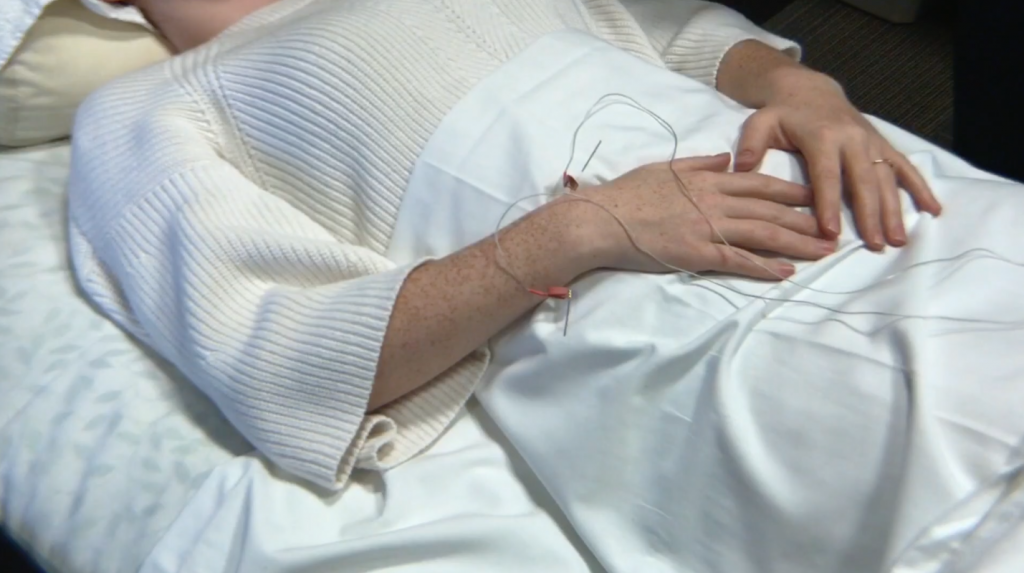
Attach the ion pumping cords
I place the two leg points first, then the two arm points. (8 Extra pairs always combine a leg point with an arm point.) These may be unilateral (same side of the body), or crossing the body – one leg and the opposite arm. Be careful to attach the cords to the correct points of the pair, and be careful that you use the correct polarity!
IPC cords have a black clip and a red clip. In this case, attach the black clip to KI 6, listed as blue, negative, and the red clip attached to its paired red point, HT 5 positive. LR 4 will get the black clip, and PC 6 will get the red clip. Because the ion-pumping transfer is so powerful, other traditional parameters for tonification and sedation, such as direction and coordination with respiration, are less important.
Ion-pumping cords send electrons in one direction. In our protocol, we want to send excess energy to the place of deficient energy. The cords send energy from black to red. So, if we see that KI 6 is blue, that means we need to sedate that point, and send it to HT 5, which is red. With the AcuGraph Divergent menu, our colors coordinate well. The black clip goes to the blue point, and the red clip goes to the red point.
As we mentioned above, for the 8 Extra treatment, there will be cases where only 3 points are listed at the top. Here, one point will be used for two separate pairings. On AcuGraph’s “Treatment Plan”, one point will show one polarity/color, while 2 points will show the other polarity/color.
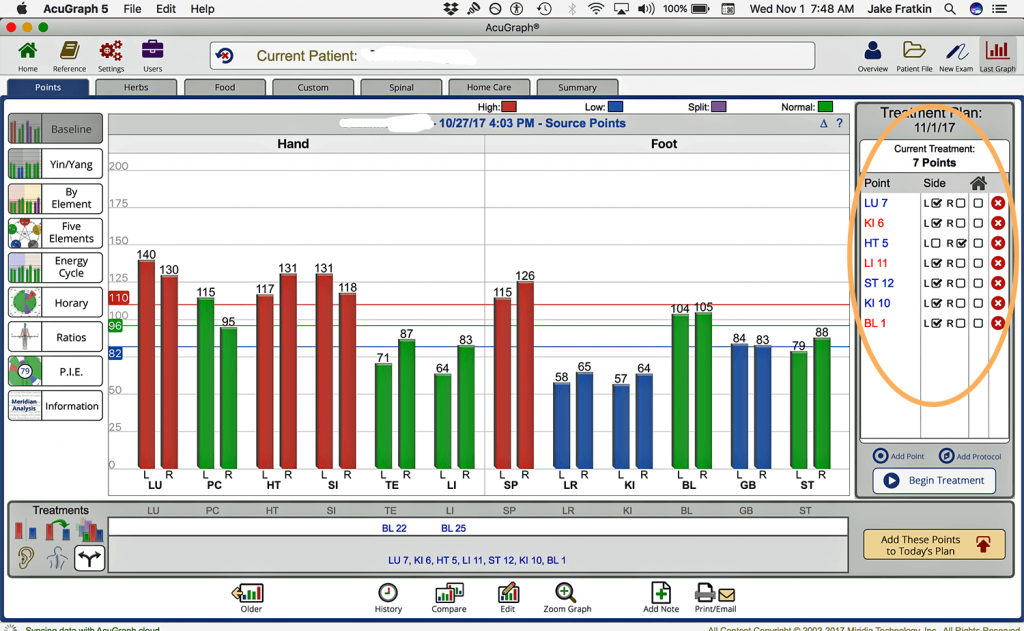

In the graph shown above, we see there is a total of 7 points in the “Treatment Plan”. (I have removed the last 4 Bladder-shu points.) The bottom four are always the points recommended for the Divergent treatment, in this case LI 11 – ST 12 and KI 10 – BL 1. The top three show LU 7 (blue), KI 6 (red), and HT 5 (blue). Here, the point with one color will be used twice (KI 6), with two separate IPC attached to this one point, both using the red clip. The cords will go out to the two points with the same color (LU 7 and HT 5), which are blue on the graph and will use the black clip. This allows the excess of the Lung channel as well as the excess of the Heart channel to feed into the deficiency of the Kidney channel.
Once the 3 or 4 Eight Extra points are attached with ion-pumping cords, we go on to the Divergent treatment.
Step 5: The Divergent Treatment
The Divergent treatment balances the internal zang-fu, based on their 5-Element partnership. In our example, the right side treatment says PC3 and GB12. This will balance PC and TE. On the graph, you can see that TE is excess, while right side PC is low. The Divergent treatment uses head/neck meeting points where the excess channel can meet with its deficient partner. On the left side, we have LI 11 and ST 12. Here, Lung energy will feed into and support the Large Intestine, meeting at ST 12, its head/neck Divergent meeting point. The Divergent balance is a deep and clever way to harmonize the internal organs. More about that in a future post!
So, in our case above, we treat PC 3 and GB 12 (right side) using an ion-pumping cord, and LI 11 and ST 12 (left side) using an IPC. Black clip to the point we are sedating (blue color on menu), and red clip to the point we are tonifying (red color on menu). Remember, Divergent pairs are always unilateral, performed on the same side.
Step 6: Let the Cords Sit
Manaka felt that a 10 minutes with an ion-pumping cord was sufficient to achieve the balance between two meridians (or two points on the same meridian).
In this treatment, when the last cord in attached, the treatment only needs another 10 minutes, but the cords can remain longer when doing a branch treatment. Once the four pairs are in place, (two for 8 Extra, 2 for Divergent) you can do branch treatments on the body or ear. In Miki Shima’s protocol, the branch is best done using auriculotherapy, and of course, Kimberly has been training you in this all along.
Step 7: Buy Ion Pumping Cords
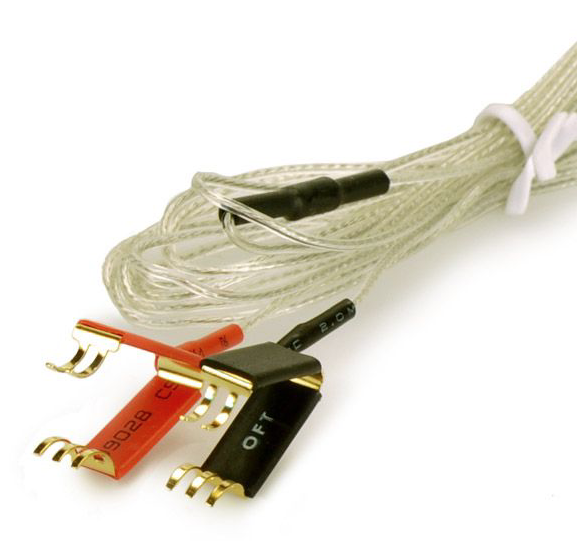 Exciting, no? I would love for you to start doing these treatments right away! Make sure to buy 2 sets of ion-pumping cords (four cords) in advance.
Exciting, no? I would love for you to start doing these treatments right away! Make sure to buy 2 sets of ion-pumping cords (four cords) in advance.
You can purchase ion pumping cords on the Miridia Technology online store. It is wise to add on the ion pumping cord tester so you can periodically check that your cords are functioning properly.
With 4 cords and a tester, you’ll be ready to start immediately implementing the divergent treatment into your practice.
Buy Ion Pumping Cords/Testers Here >>
I recommend you start doing the Divergent treatment so you can get used to its practical application. In future blog posts, I will explain in more detail why the Divergent treatment is such a profound treatment for deep balancing, as well as its fascinating history and development. The Divergent treatment works at three levels: The qi and blood of the meridians, the musculoskeletal structure, and the internal zang-fu organs – all at the same time! With eight needles! Don’t be surprised to find your patients expressing deep relaxation, and watch as their complaints gradually disappear with treatments.
Please email me with any questions, and we will share some of these, with responses, in future posts: info@drjakefratkin.com.
————————————————————————————————
Additional Resources
To learn more about ion pumping cords and the Divergent treatment, consider utilizing the resources below for more in-depth information, including a webinar series dedicated to the Divergent treatment and using ion pumping cords.
Part 2 of the Patients are Getting Better, Faster webinar includes an in-depth demonstration video of how to use ion pumping cords correctly.
1. Webinar: Patients are Getting Better, Faster (Be sure and register for both parts 1 and 2)
2. Blog Post: Case Study: Ion Pumping Cords
Other Posts in this Series
To read parts 2, 3 or 4 of the 3-Level Acupuncture Balance series, click the links below:
- Part 2: Historical Development
- Part 3: More on the Eight Extraordinary Channel Balance
- Part 4: More on the Divergent Channel Balance
————————————————————————————————

Jake Paul Fratkin, OMD, L.Ac. trained in Korean and Japanese acupuncture since 1975, and Chinese herbal medicine since 1982. He is the author of Essential Chinese Formulas (2014), and Chinese Herbal Patent Medicines, The Clinical Desk Reference (2001). Jake practices in Boulder, Colorado, where he specializes in internal disorders, infections, and pediatrics.
amazing collection